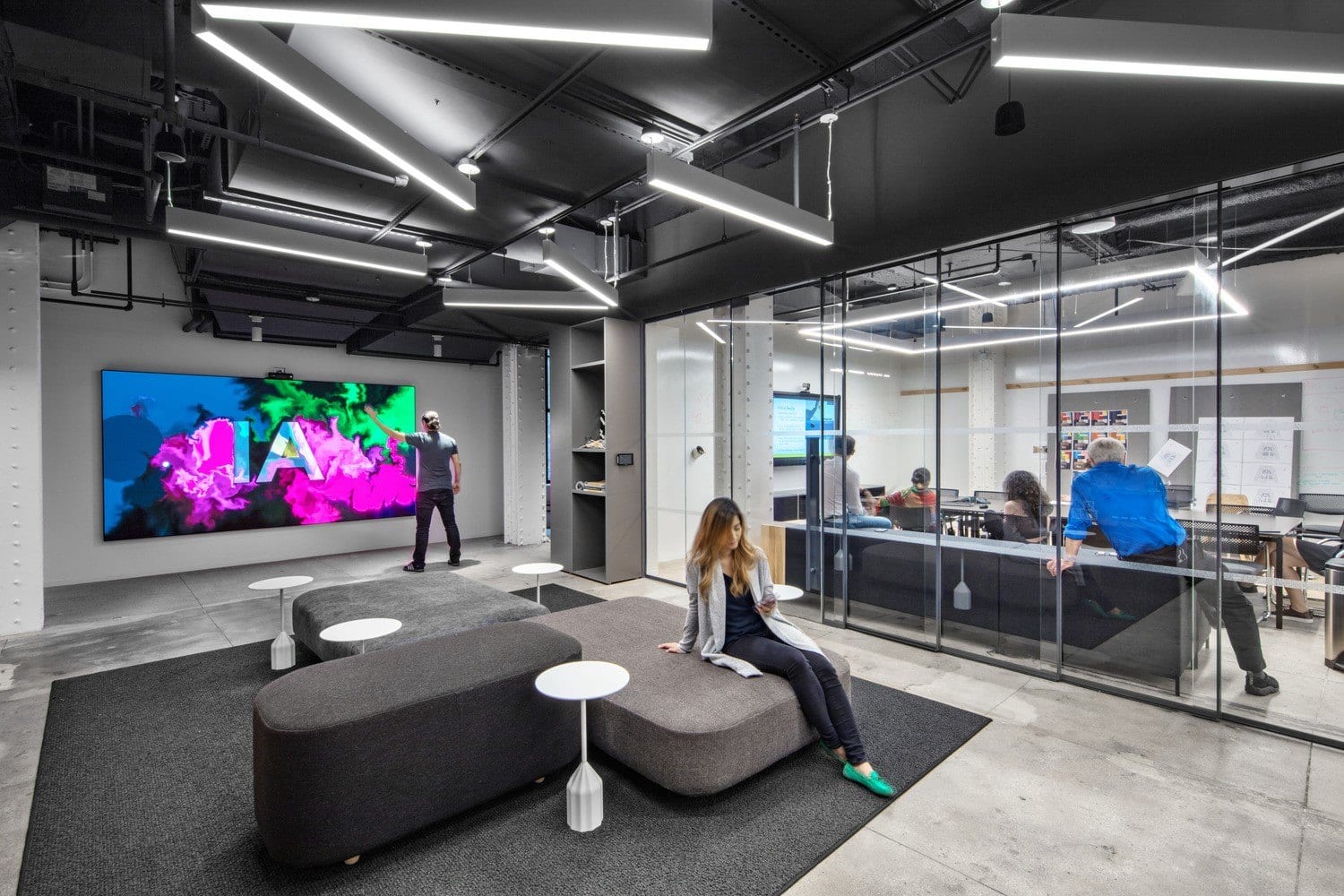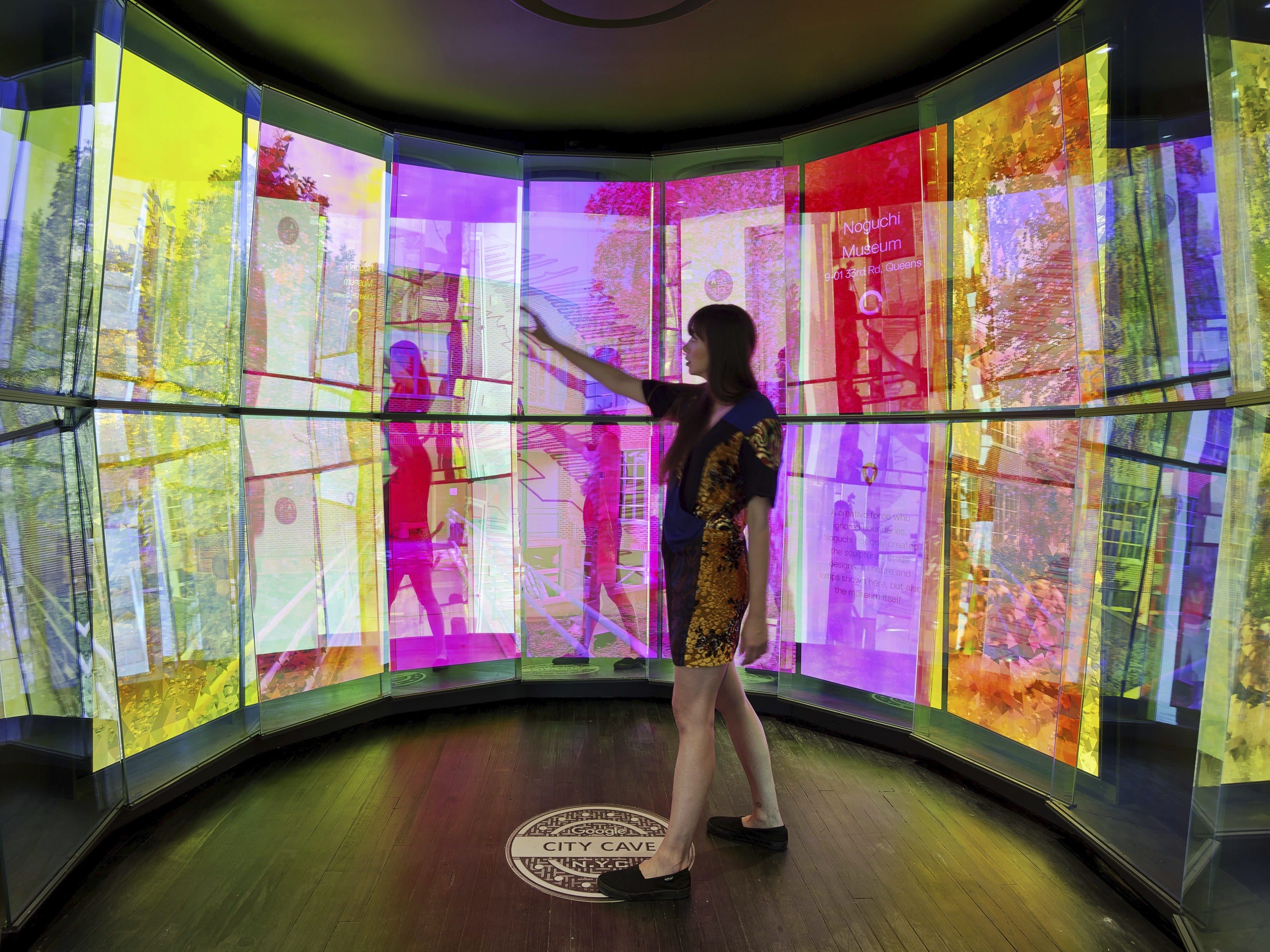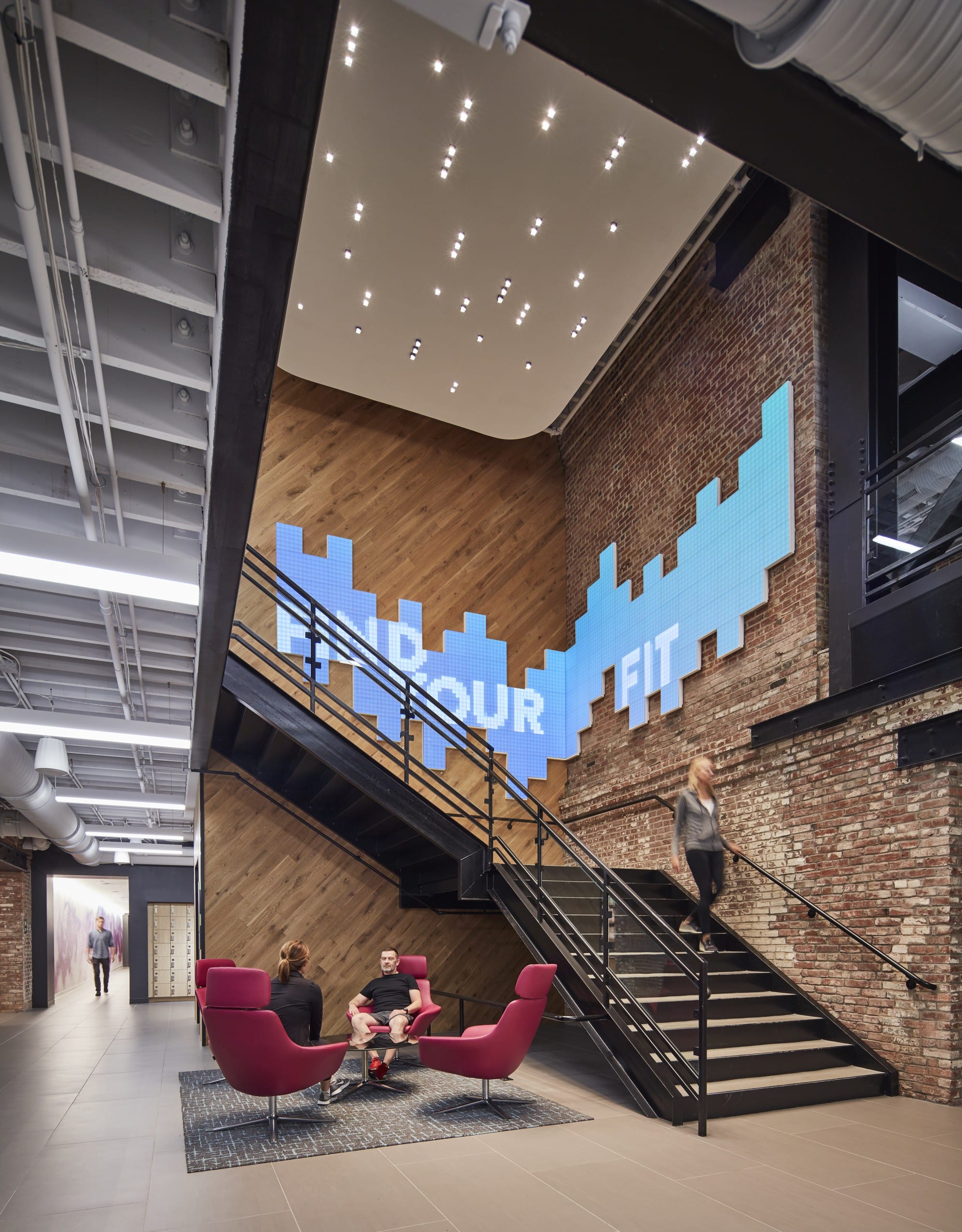
The fully hackable studio lends itself easily to welcoming guests and to social events. Photography © Eric Laignel.
Activating the reception area of IA’s new Manhattan office, on the 12th floor of a landmark 1890s skyscraper, is a wall-mounted LED screen displaying a mesmerizing simulation of real-time colorful fluids that respond to movement by swirling and morphing similar to a lava lamp. It’s a whimsical (and hypnotizing) counterpoint to the otherwise neutral, industrial-inflected palette—and one of many design elements that invite staff and visitors to interact with their surroundings.
The screen wall is also an evocative demonstration of IA’s expertise in creative technology, an emerging discipline that melds art, design, and digital interfaces to create dynamic, immersive spatial experiences—“ones that engage end users not just on a physical level but also on a virtual and emotional level,” says Ali Ucer, the firm’s Creative Technology leader and a member of the experiential graphics department. “It’s a wonderful way to convey a client’s unique story.”
Technology is, of course, ubiquitous in the contemporary workplace, from mobile devices and cloud-powered software platforms to occupancy sensors and thermal-control apps—tools that help us do our jobs more efficiently, effectively, and productively. But technology is also a medium capable of sparking joy and humanizing a space by connecting occupants with their environment in a visceral manner. “Incorporating elements of creative technology transforms a workspace from day one,” Ucer affirms.
Those elements can take many forms, and each installation is sui generis. A centerpiece of Google’s New York office, for instance, is City Cave, an alcove surrounded by screens on which images of the Big Apple pop up in response to users choosing specific emotion-related search terms. Elsewhere, in a pre-function area, screens mounted overhead render inhabitants’ speech and movement as pulsing waves of light and color.

City Cave in Google's New York office. Photography © Eric Laignel.
For Wel at Humana TM, a downtown Louisville fitness center open to company employees and community members, Ucer’s team devised a digital installation that wraps two walls of a central stairwell. Motion-tracking LED panels, arranged in a freeform configuration, are programmed to cycle through combinations of shapes and colors that change based on the time of day and the day of the week. “We wanted a prominent design focal point that would both lure people in and reflect the activity unfolding around them, creating a sense of community and an experience,” explains Humana workplace solutions fitness operations leader Nick Nosko. The stair leading down from the entry area to the lower-level group fitness and locker rooms proved an ideal spot for what Humana dubs the “heartbeat” of the facility. “The wall is great: It’s big, it’s bright, and interactive—people love it!” says Nosko. “This is a technology that connects.”

A custom LED interactive technology wall responds to the movement of members passing by. Photo © Tom Harris.
Now that For Wel at Humana TM has been operational for a few months, the client is truly starting to understand the possibilities that the feature wall unleashes. “We’re thinking about programming opportunities such as displaying seasonal messages, and new ways we can speak to members through digital graphics,” Nosko explains. Ucer loves seeing clients take ownership of the tech-driven artworks his interdisciplinary team of graphic, industrial, and UX designers devise. He advocates features that visualize data unique to a brand or organization, “which makes the content more relevant, tangible, and impactful and helps trigger a sense of belonging.”
The secret sauce for a successful project is an inspired collaboration. “The real innovation happens when all the partners—client, designer, vendors—are aligned and working together toward the solution,” Ucer says. A fully custom design, though typically requiring more upfront investment than does an installation that makes use of an existing product, will offer myriad advantages over time. “That’s where the magic happens,” Ucer notes.
He advises clients to be realistic about what degree of support and maintenance they can handle: For example, systems designed to run 24/7 are inevitably more high maintenance than ones that are turned off when a space is not occupied. And a customized application of an off-the-shelf product may be preferable in situations where a client lacks an on-site AV team and will need to rely on an outside vendor to handle servicing and repair. Ideal is when the client has programming capabilities or some technical know-how in-house. “But I’ve found that even big tech companies are not always AV-savvy,” Ucer notes. The burden is on his team to create what he calls “seamless” technology that’s almost an extension of the body. “In a workspace, there should be no learning curve. The technology should be self-explanatory and intuitive. It should feel magical.”
Looking to the future, Ucer and his creative technologists are pushing the envelope in terms of designing features, platforms, and systems that “foster a heightened emotional response,” he says. Another trend is connecting multi-office companies, using screens not only for interactivity but as a portal to create a seamless communication experience. A corrective to what is generally perceived as the alienating effects of technology, Ucer strives to envision tech-driven design elements that “pull human nature forward and together.”
IA is a global firm of architects, designers, strategists, and specialists. We focus exclusively on environments through the lens of interior architecture—a radical idea in 1984, when IA was founded. We are highly connected agents of change, committed to creativity, innovation, growth, and community.
IA is a global firm of architects, designers, strategists, and specialists. We focus exclusively on environments through the lens of interior architecture—a radical idea in 1984, when IA was founded. We are highly connected agents of change, committed to creativity, innovation, growth, and community.


